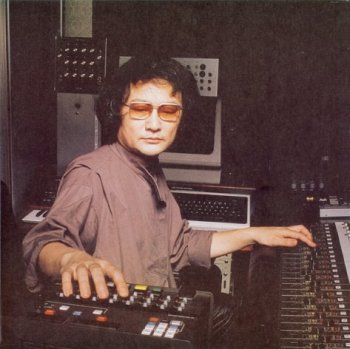| B i o g r a p h y |
 I
saw a synthesizer on the record jacket, behind Bach. For the first
time, I discovered that the synthesizer is not an instrument to compose
music by using the sounds of existing instruments, but a new instrument
or new machine which creates unlimited sound sources.
I
saw a synthesizer on the record jacket, behind Bach. For the first
time, I discovered that the synthesizer is not an instrument to compose
music by using the sounds of existing instruments, but a new instrument
or new machine which creates unlimited sound sources.
So recalled Isao Tomita in 1977 on having heard Wendy Carlos' seminal 'Switched-On Bach', the record which brought the awareness of the public to the synthesiser in 1968. Carlos' academic attention to detail and virtuoso musicianship clearly impressed Tomita as much as the listening public, and he was to take delivery of his first modular Moog synthesiser, along with a sequencer, in 1971. Less than three years later, the world was to be bowled over once again by the strange, still-novel timbres and tones of analogue synthesis with the release of Tomita's worldwide debut, 'Snowflakes are Dancing'.
Whereas Carlos' had interpreted J.S. Bach's highly-structured contrapuntal early eighteenth-century music in a faithful stylistic recounting, expressing the pieces in bold colours, Tomita's approach to Debussy's late-nineteenth century 'impressionist' tone poems and playful piano studies showed another, perhaps more muted side to the synthesiser, while establishing Tomita's contrasting musical sensibility as equally as strongly. In 'The Oxford Dictionary of Music', Michael Kennedy describes Debussy's music as being 'a sonorous halo', and this description entirely fits much of Tomita's recorded work.
Isao Tomita was born in Tokyo in 1932, and at the age of three moved to China with his father, where he remained for five years before returning to Japan. As a student he took private lessons in composition, orchestration and theory while reading art history at Keio University in Tokyo. At the same time, he honed his art and supported himself by composing for local orchestras.
Upon graduating in 1955, he embarked on a full-time career as a composer for film, television and theatre. An early work, 'Wind Mills' was accepted by the Japan Federation of Choral Organizations as the song to be used for all entrants in the national choral competition, and more commissions followed, including writing the theme music for the Japanese Olympic gymnastics team for the 1956 Olympic games in Melbourne, Australia. Over the next fifteen years Tomita consolidated his reputation in Japan with major commissions for NHK, the national Japanese television network, including regular soundtracks for long-running historical dramas, and a tone poem based on his score for a popular TV show called 'White Lion', which was performed by the Tokyo Philharmonic.
By the late 1960's, and with the impetus of Wendy Carlos' and Robert Moog's work with synthesisers, he had turned his interest to electronic music. Upon acquiring a customised Moog III synthesiser, similar to the one in the photo on the sleeve of 'Switched-On Bach', he began building his home studio. Over the next fourteen months, 'Snowflakes are Dancing' was crafted. Worldwide reaction on its 1974 release was immediate and massively favourable, and made him the first Japanese artist to be nominated in four categories for Grammy awards in 1974. It also received the NARM award for Best Classical Record in that year.
It was, as with 'Switched-On Bach', popular with classical and pop audiences alike, and the Electric Light Orchestra used it as the opening music on their tour of the same year. In contrast with Wendy Carlos' debut six years earlier, 'Snowflakes are Dancing' was released in both conventional stereo and in the doomed format of quadraphonic, or four-channel sound. A descendant of quad, Dolby Surround, was utilised in the 1991 re-release of 'Snowflakes are Dancing' and Tomita's four following albums.
'Firebird', the May 1975 follow-up was just as successful, selling over 100,000 copies in three months, getting to the top of the classical and pop charts, and even appearing on the jazz charts as well. Electronic interpretations of popular classical works continued, each with impeccable sonic credentials and craftsmanship. With 'The Bermuda Triangle', also nominated for a Grammy award in 1979, a fifth audio channel was added to the quad mix, dubbed 'Pyramid Sound' by Tomita. Impossible to encode onto a standard stereo LP, ironically it was introduced with the demise of quad as a viable format.
The analogue synthesisers of the previous eight years were given more of a back seat with the introduction of digital instruments on 'Grand Canyon', for which Tomita was again nominated for a Grammy award in 1982. Easier to control and use with the benefit of MIDI, digital was very much the 'in-thing' as far as almost everyone was concerned throughout the '80's, a situation being now challenged with the renewed interest in analogue machines in the electronic music making community of the '90's. Tomita virtually abandoned analogue with the acquisition of his custom-built, one-of-a-kind Casio Cosmo system around 1984, although for his new recording 'Bach Fantasy', he has revisited his old analogue instruments, with digital sampling devices being used to recreate the sounds of old.
Tomita has been involved with musical events throughout the world such as his 1984 'Mind of the Universe' concert in Linz, Austria which drew 80,000 people. In 1986, a gigantic concert called 'Back to the Earth' was held in New York in commemoration of the centennial of the Statue of Liberty. A 'Sound Cloud' concert was also held in Sydney to mark the occasion of the Australia Bicentenary in 1988.
Tomita remains at the top of his profession as he celebrates over 40 years in music. He is now the Honorary President of the Japan Synthesizer Programmers Association. As I recall reading in the 'Melody Maker' newspaper in 1975, "Nice Tomita, Tomita nice".